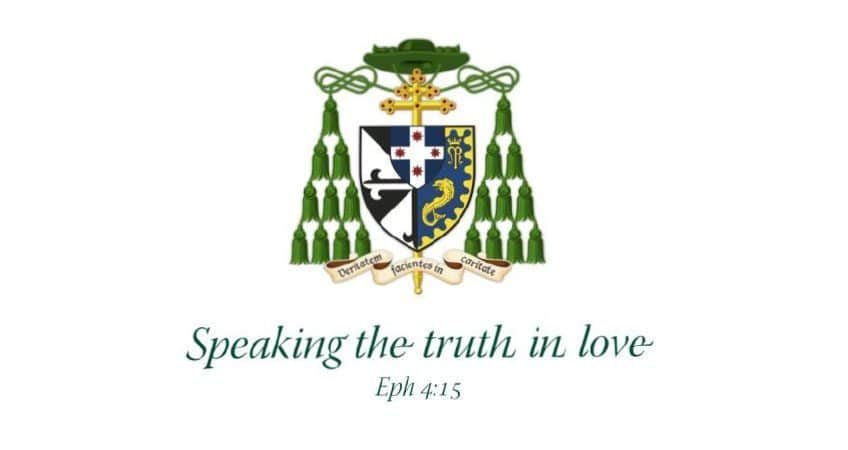FERVERINO FOR THE 17th ANNUAL CAROLS WITH THE ARCHBISHOP AND THE WORLD YOUTH DAY ORCHESTRA

Holy Family Church, Maroubra
Where do Christmas carols come from? Our word carol derives from the medieval Latin word choraula and medieval French word carole, a secular circle-dance accompanied by one or more singing minstrels. Some trace it all the way back to the χορός of the ancient Greeks, a choir and dance troop that became a feature of the staged tragedies, and the χοραυλής, the flute player accompanying the chorus.
But the origins of the name and idea of the carol are contested. Some point to the popular processional songs in medieval festivals and mystery plays, and suggest the word actually derives from Kyrie eleison—Lord, have mercy—from which comes the Dutch word for carol leisen and the middle English equivalent kyriol.
Whatever the etymology, the carol evolved with elements of song and dance, whether in the street performances of secular minstrels or the carry-on of sacred ministers, in public squares or holy sanctuaries, or that mixture of the two, the popular street processions for feast days, with costumes, banners and music, floats with statues, and plenty of carousing. These songs were popular because they were in the local tongue, their melodies catchy and rhythmical, and they required no training in chant or polyphony. Come the Reformation the Protestants might not have favoured feast days, dancing and revelling but they wanted to bring sacred music “back to the people” and hymns and carols seemed the way to go…
So which is it to be: the song and dance of the streets or of the sacred movements of churches and cathedrals? My thought tonight is that carols capture the spirit of both, that this is what gives them their power and attraction, and that this makes them especially useful in Advent and Christmas tides, and perhaps especially in times of COVID.
First, song and dance were features of the very first Christmas. The opening chapters of Luke’s Gospel read like Christmas: the Musical. Visited by the newly-pregnant Mary, old aunt Elizabeth whoppees while the foetal John dances in her womb. Mary then responds by singing her Magnificat and stays long enough to assist at the boy’s birth and hear his recently-dumb father sing the Benedictus. Six months later her turn comes to give birth, and a choir of angels sings the Gloria while assorted shepherds, kings and farm-animals tune in. Then old Father Simeon takes the Babe in arms and sings Him the Church’s lullaby, the Nunc Dimitis. If this last anthem was sung in the Temple, the rest were on the streets as it were, perhaps with St Joseph recording the lyrics!
So carols are no solemn or plaintive form of song. Indeed, their very structure of chorus and verse is a dancing-tune form, meaning we were never meant to sit still through them. I could see some of you tonight were ready to jig when we came to Ding! Dong! Merrily on High, I saw three ships and The Twelve Days of Christmas and you may yet break out into dance come Hark the Herald Angels Sing! Though our carols are often deeply doctrinal, they are never dryly scholastic: theirs is a deeply felt theology, enacted theology, danced theology.
Secondly, what is the truth these carols preach without a pulpit, the doctrine they dancify? That the Infinite God was so smitten with humanity He gave His all, His very Son, to us. He became man to be with us in the flesh, to touch and be touched, be seen and heard, to experience the ups and downs of human bodily life, from presence to friends and partying with them, to absence of friends and aching for them. And that kind of God-with-usness has the power to save. If any message was going to get even the most staid of us carolling it’s that, but the music also helps us to ‘get with’ the message, to move with it and be moved by it.
After seeing God made baby and holding him in their arms, the shepherds returned “singing God’s praises for all they had heard and seen” and “amazing their friends and neighbours” (Lk 2:8-20). The Christmas story is for pondering, sure, as Mary did (Lk 2:19,33,35,51), but it is also for reverberating abroad so others might join the music.
Thirdly, after two years of forced separation, social distancing and radical isolation due to COVID-19, we know very well that good as phone calls, emails and Zoom are, they’re no substitute for being together in person. As spatial beings, friendship for us is about drawing ‘together’ not apart, being ‘close’ to those ‘near and dear’ to us, being ‘there’ for each other not just notionally or virtually but actually. There’d be little comfort in being told a pure Spirit dwelling in inaccessible light has decreed our salvation. The love of the Christmas God runs so deep it made Him one of us, sharing our space, getting ‘up close and personal’ with us physically and spiritually. The lyrics of our carols capture these truths and sentiments, as did the first carols of the angels, Mary, Zechariah and Simeon. But it’s the music and rhythms that co-opt hearts and souls, voices and bodies for the same celebration.
May the Christ-child dwell in the manger of your hearts this Christmas. May He scatter the darkness of pandemic, lockdowns and isolation. May His story so fill you with joy and hope that you break out in song and dance. May He bless you and your loved ones and keep you safe in the year ahead!
WORD OF THANKS AFTER THE 17th ANNUAL CAROLS WITH THE ARCHBISHOP AND THE WORLD YOUTH DAY ORCHESTRA
Holy Family Church, Maroubra
It’s been a great pleasure to join you once again for these wonderful carols, especially after last year’s COVID safety restrictions forced cancellation, making these the 17th Maroubra Carols in 18 years.
I thank Dr Mark Schembri and the Maroubra World Youth Day Orchestra, and our excellent soloists, and all who’ve yet again worked so hard to make tonight happen. I am pleased to acknowledge the presence tonight of His Excellency, General Hon. David Hurley AC DS FTSE, Governor-General of Australia, and Mrs Hurley, both long time friends of the Maroubra carols; Hon. Damien Tudehope MLC, Minister for Finance and Small Business and Leader of the House in the Legislative Council, representing the Premier; Hon. Matt Thistlethwaite MP, federal Member for Kingsford-Smith; Mr Michael Daley MLA, Shadow Attorney General and state Member for Maroubra; Mr John Bennett OAM, Vice President of the Royal Agricultural Society of NSW; Mr David Mortimer AO, Chair of Opera Australia; Judge Gerard Phillips, a member of the Council of St John’s College within the University of Sydney; a great number of my fellow clergy; and other distinguished guests.
I thank our parish priest, Fr Allan Casquejo, for hosting this wonderful event and acknowledge the Parish Priest emeritus Fr Bill Challenor, who was recently granted the papal honour of the cross for Service of Church and Pope after more than 60 years of priestly service.
Tonight, we celebrated the God who loved us so madly he came down to earth from heaven. He so wanted to be part of our lives that He assumed our human nature, body and soul, and was born in a lonely cattle shed where a mother laid her baby in a manger for his bed. He came close, as close as a baby held in our arms, and tonight we joined the angels, shepherds, kings and parents singing His praises. We thank our hosts, organisers and performers for recalling us to that wonderful task!

